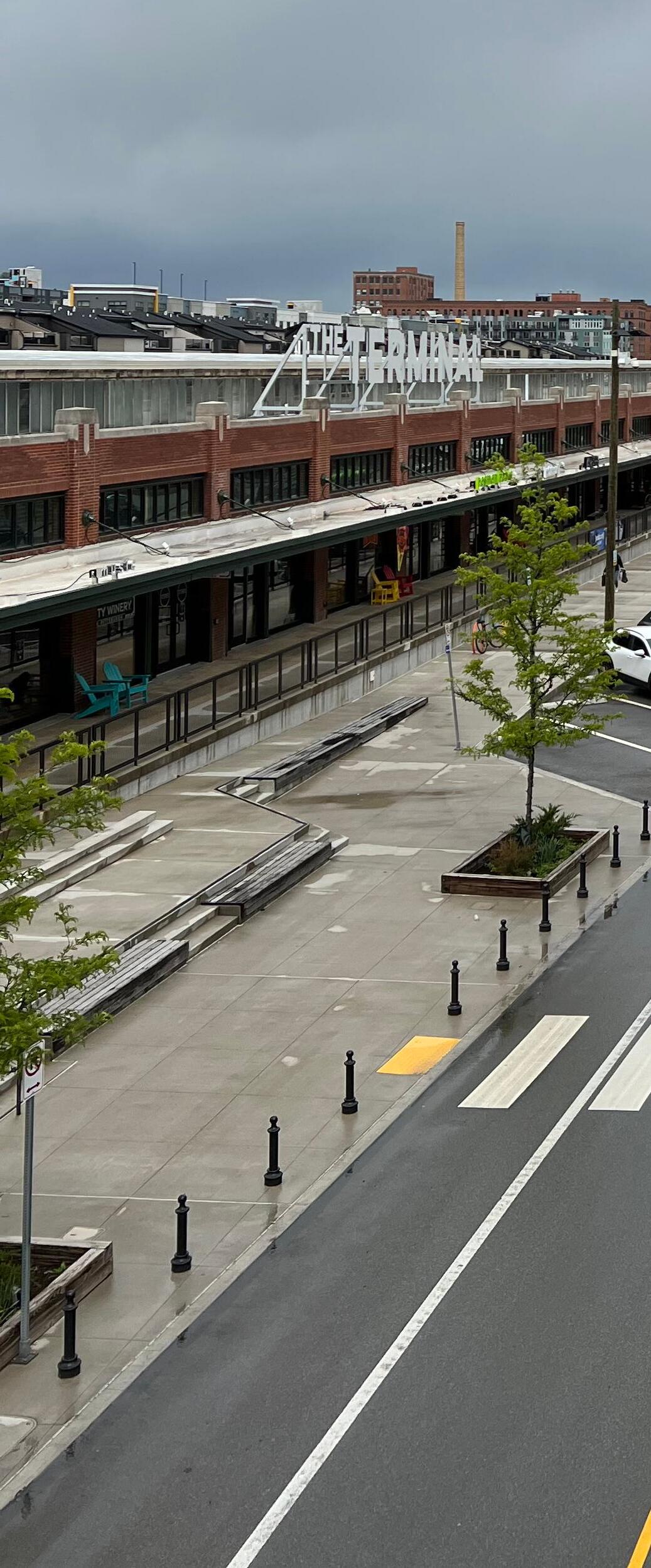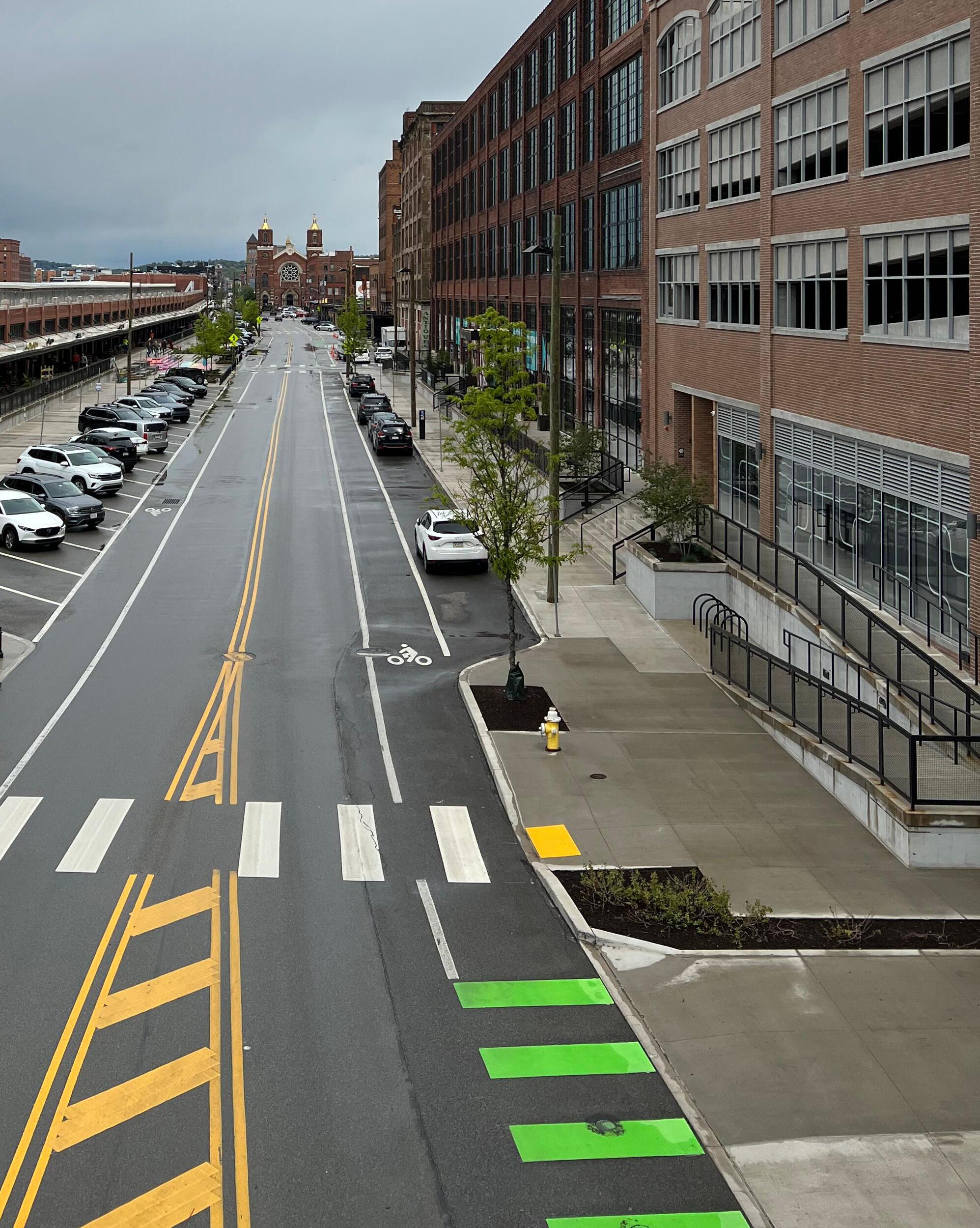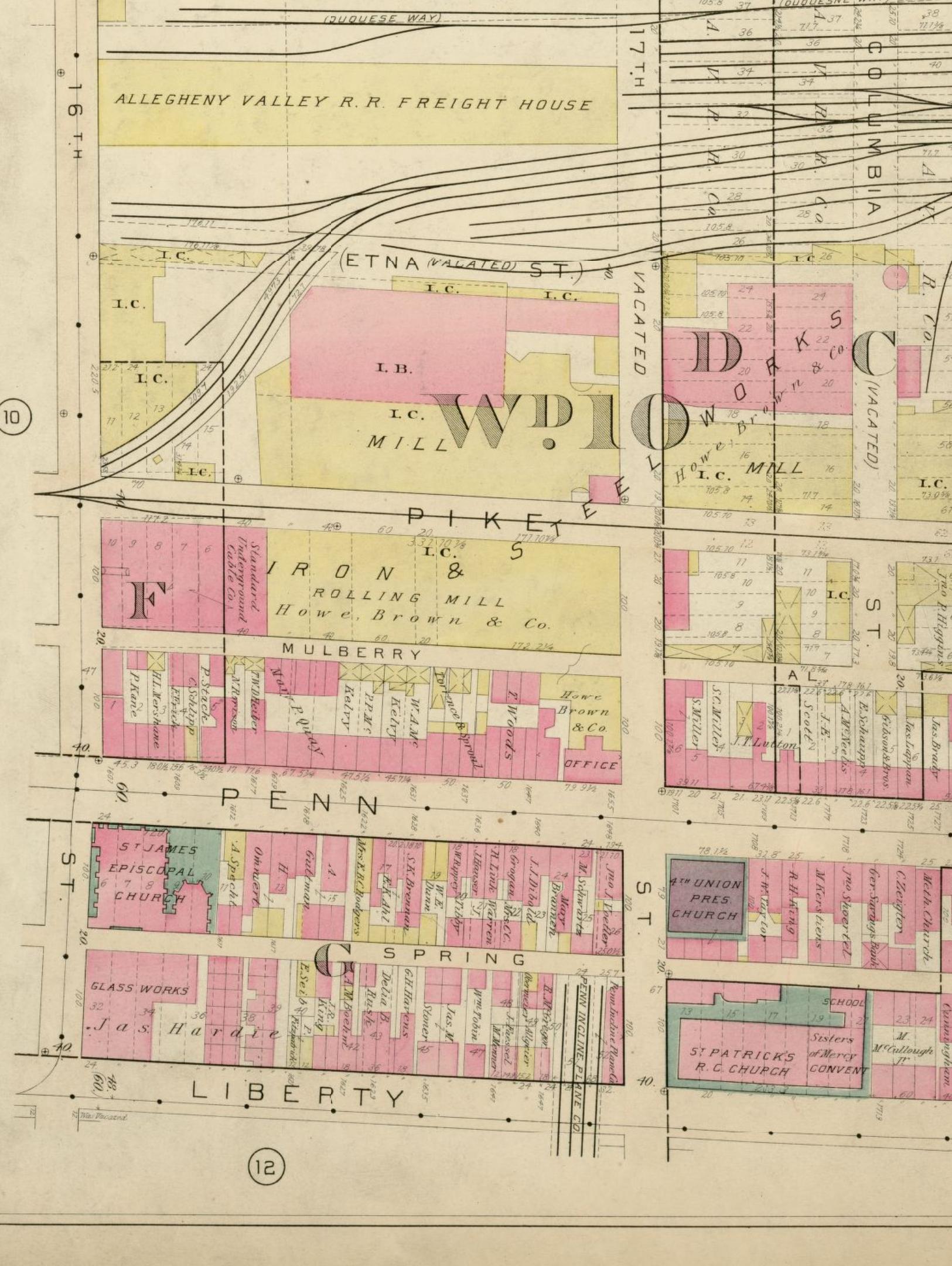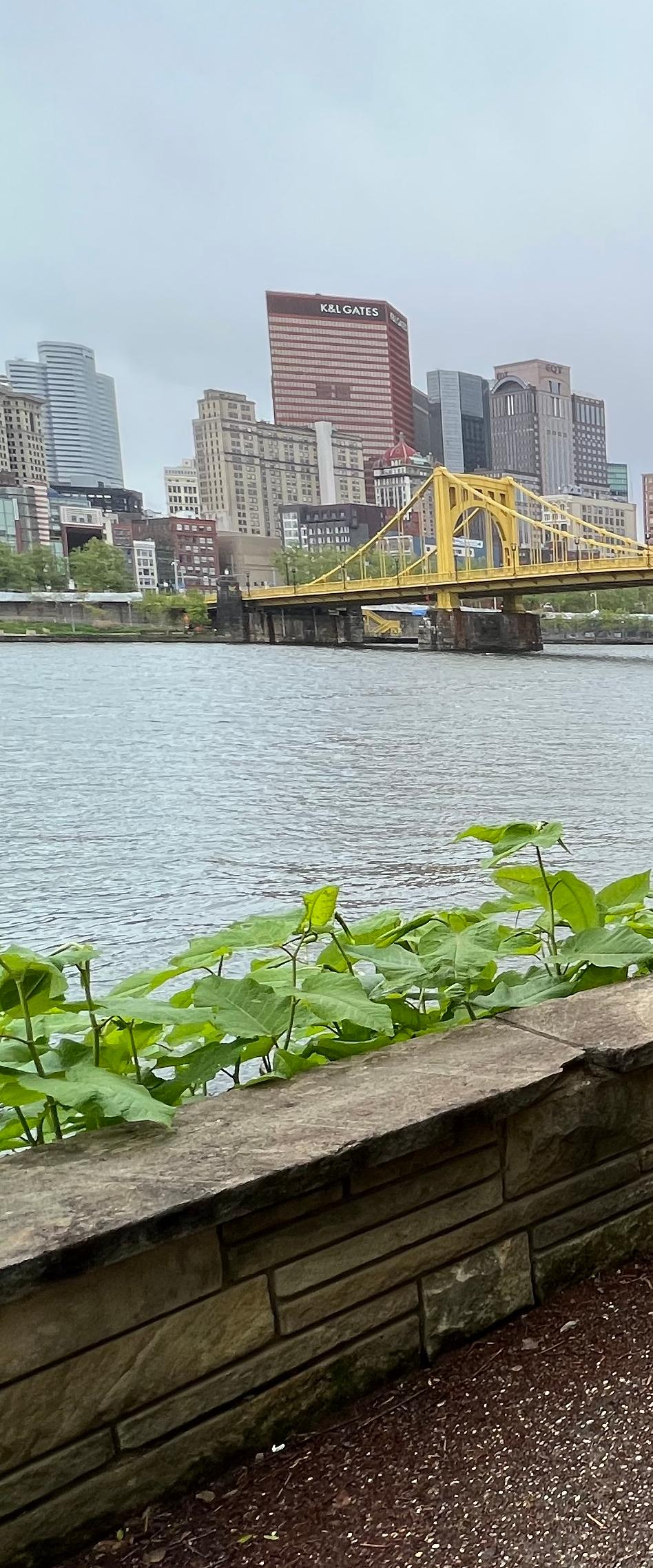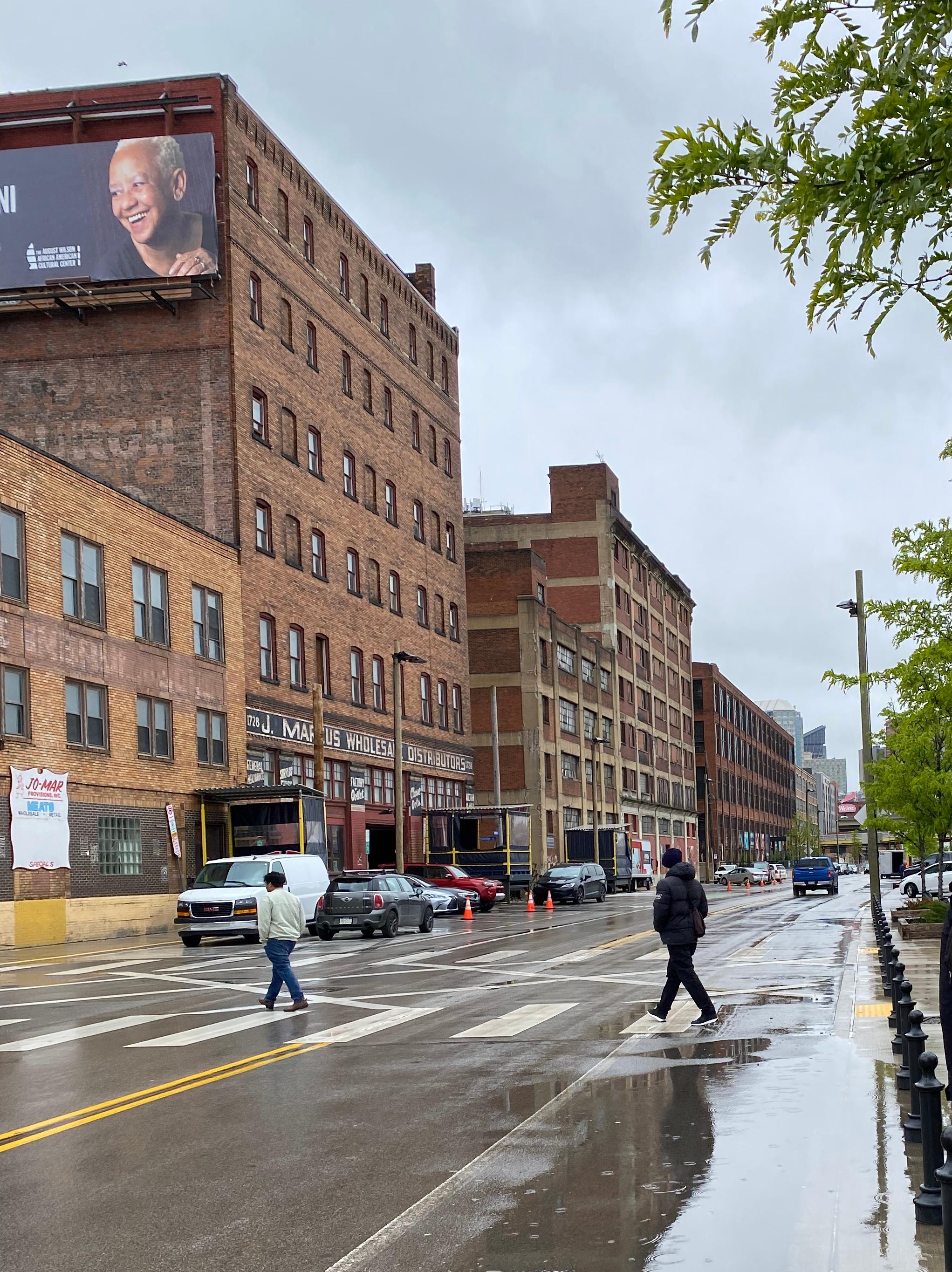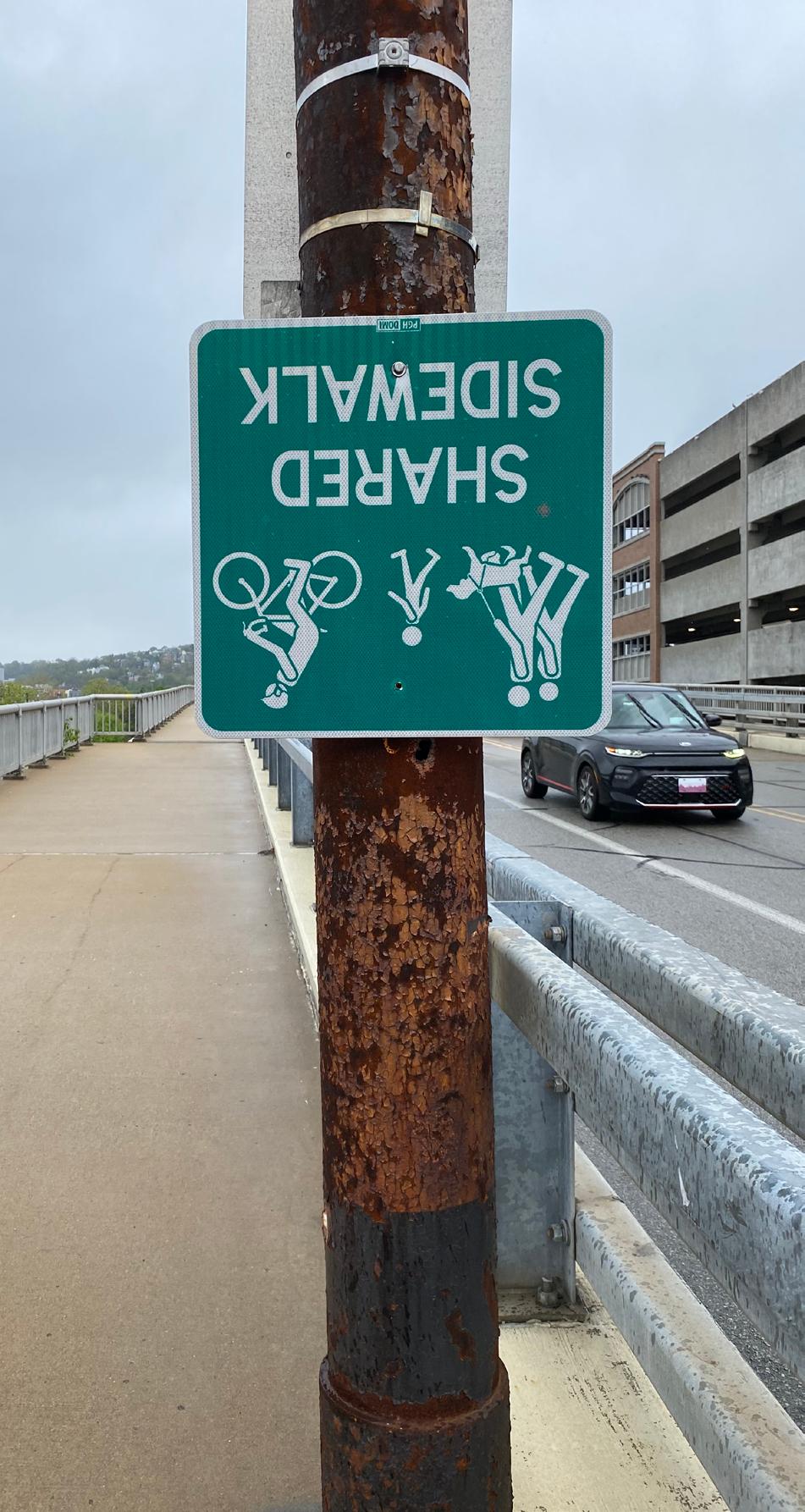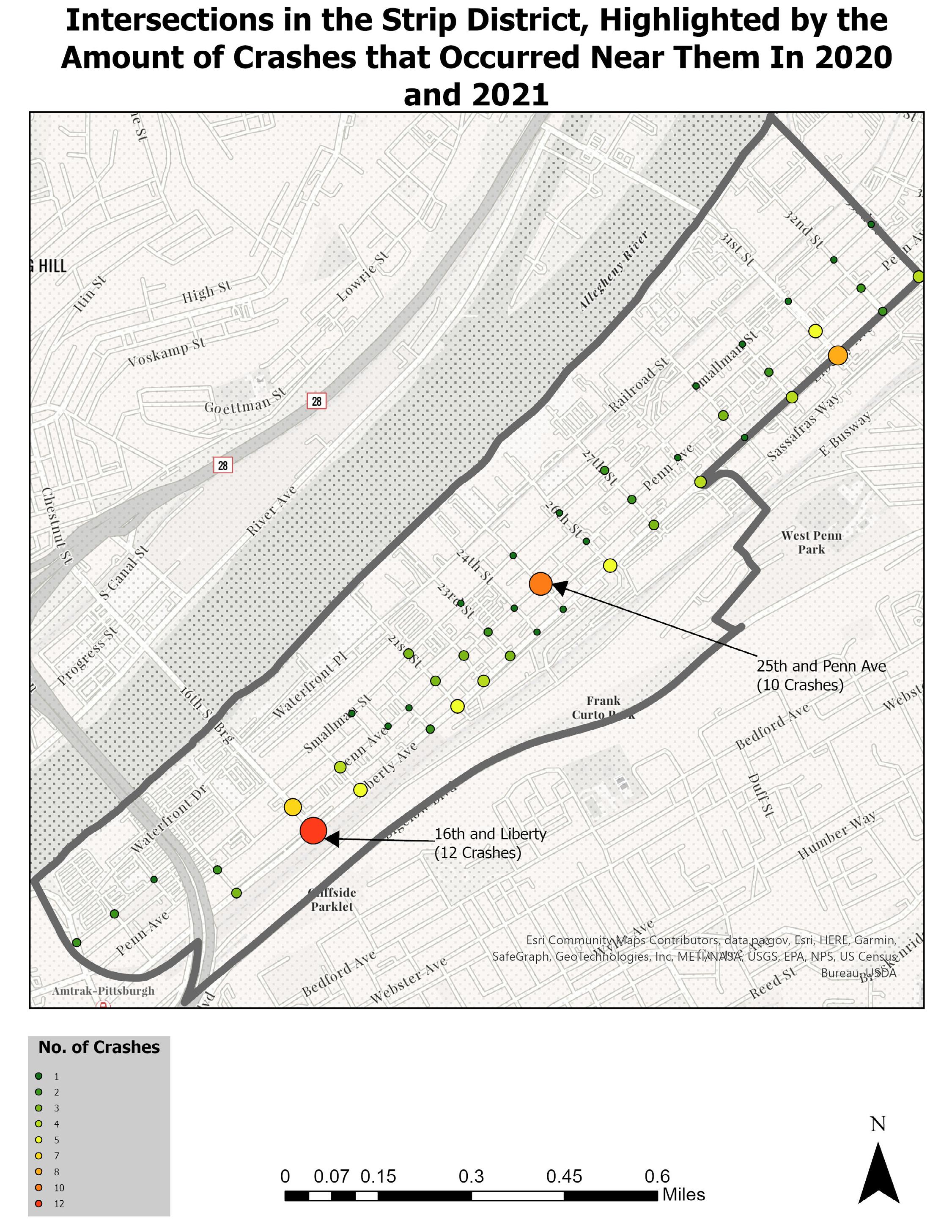05 Conclusion
As the Strip District enhances commercial and residential space and adapts to the influx of people, there will be increased pressure on the area’s mobility infrastructure. With this increased population density, it will be crucial to ensure that inviting infrastructure is set in place to help people move safely and efficiently throughout the Strip. Transformative solutions like circulators are viable methods to achieve this, but are more feasible in the longer term, and therefore do not immediately address the population influx that has already begun, as well as the mobility and safety issues that are stemming from it in the present. Making the District safer through interventions that involve a human-centered design to mobility rather than expanding vehicle infrastructure will encourage more stakeholders to bike and walk within the District, mitigating an increase in congestion and further improving mobility. Overall, this method can act as a way to reduce significant emissions from vehicular sources locally, helping the Strip be a more sustainable neighborhood.

Crashworthiness of the bollard system by experimentally validated virtual test
and Investigation of Critical Impact Point of Steel Guardrails Affecting
The Effectiveness of Selected Devices to Reduce the Speed of Vehicles on Pedestrian Crossings
Cushions A Series of Vertical Deflections, a Promising Traffic Calming Measure: Analysis and Recommendations for Spacing.
Raised Sidewalks
Abou-Senna, H., Radwan, E., & Mohamed, A. (2022). Investigating the correlation between sidewalks and pedestrian safety, Accident Analysis & Prevention, Vol. 166. https://doi.org/10.1016/j.aap.2021.106548 P, S, L $6-12 per sq ft
Curb Radius Reduction P $6-12 per sq
Federal Highway Administration. (2013). “Raised pedestrian crossings” in PEDSAFE: Pedestrian Safety Guide and Countermeasure Selection System. http: //www.pedbikesafe. org/pedsafe/countermeasures_detail.cfm?CM_NUM=7
Curb Extentions (Curb
Medians and Refuge Islands
Street Lighting
Specific Paving Treatments
Diverters
Right-Turn-on-Red Restrictions
Federal Highway Administration. (2008, September). Desktop reference for crash reduction factors, Table 11 [FHWA-SA-08-011].
Harkey, D.L., R. Srinivasan, J. Baek, F. Council, K. Eccles, N. Lefler, F. Gross, B. Persaud, C. Lyon, E. Hauer, & J. Bonneson. (2008). NCHRP Report 617: Accident modification factors for traffic engineering and ITS. Transportation Research Board. (2008). https:// www. hsisinfo.org/detail.cfm?
id=296&msclkid=e7f2deabd13d11ec98b9f689c6c127f9
S
significantly improve pedestrian safety, as most fatal pedestrian crashes occur in locations without sidewalks. A recent study conducted in Central Florida found the likelihood of a pedestrian crash per mile along roadways with no sidewalk is three times greater than when a sidewalk is present.
P $5,000-15,000 each ramped speed tables that span the entire width of the roadway – can reduce pedestrian crashes by 45%.
to $16,000 each
located in the median of a two-way street and provide a safe break point for pedestrians, have been found to reduce pedestrian crashes by 56%.
can help motor vehicle drivers see pedestrians sooner, thus providing critical additional time to avoid crashes. Overhead lighting, outside of intersections, is estimated to reduce all types of crashes by 23%. At intersections, the benefit is even greater – a 27% reduction in crashes.
$500 to $ 1,500 each
$50-200 per square yard
$5,000 to $85,000 each
$200 each
The use of WALK/DON’T WALK pedestrian signal indications at signal locations are important in many cases, including when vehicle signals are not visible to pedestrians, when signal phasing is complex (e.g., there is a dedicated left-turn signal for motorists), at established school zone crossings, when an exclusive pedestrian interval is provided, and for wide streets where pedestrian clearance information is considered helpful.
Paving treatments send a visual to motorists cue about the function of a street. They can also create an aesthetic enhancement of a street and be used to delineate separate space for pedestrians or bicyclists.
Diverters are measures used to discourage or prevent traffic from cutting through a neighborhood.
* Penn Ave (P), Smallman (S), Liberty (L) https://globaldesigningcities.org/publication/global-street-design-guide/designing-streets-people/designing-for-motorists/traffic-calming-strategies/ https://studio.mapbox.com/styles/bribarte/cllf7ed7v01oj01qnecmy6qmc/edit/#17.95/40.459095/-79.972429
Pedestrian Signals
LITERATURE REVIEW ARTICLE OVERVIEW METHODOLOGY
Getting an insight into the effects of traffic calming measures on road safety
Impacts of traffic calming interventions on urban vitality
The objective of this paper is to assess the significance of urban traffic calming and to get an insight into the safety impacts of local and area-wide traffic calming interventions enabling a better understanding and therefore ‘better-informed’ decisions on different schemes.
Safety effects of traffic calming initiatives have been analysed on a city-level for larger Hungarian cities and an in-depth research has also been carried out for a more detailed case from the capital of Hungary.
Results show that traffic calming initiatives have a very significant role in enhancing road safety of urban areas. Meanwhile the case study of Budapest explains observed effects in detail allowing for more accurate appraisal tools to be developed.
CITATION (APA)
Juhász, M., & Koren, C. (2016). Getting an Insight into the Effects of Traffic Calming Measures on Road Safety. Transportation Research Procedia, 14, 3811–3820. https: //doi.org/10.1016/j.trpro.2016.05.466
Go slow: an umbrella review of the effects of 20 mph zones and limits on health and health inequalitie
This paper seeks to answer whether the imposition of traffic and parking restrictions helps recover the loss of quality of life.
Transport is an important determinant of health and there is a well-established association between socioeconomic status (SES) and risk of road accidents. Effective traffic calming interventions such as 20 mph zones and limits may therefore improve health and reduce health inequalities.
Traffic calming for the prevention of road traffic injuries: systematic review and meta-analysis To assess whether area-wide traffic calming schemes can reduce road crash related deaths and injuries.
The concepts of urban vitality were studied to investigate the conditions that make streets and squares more lively and attractive to people. These conditions were condensed into a matrix of criteria – applied in the analysis of a set of streets in Belo Horizonte (Brazil) – classified into five categories according to the level of traffic calming that they were subjected. The relationships between each level of traffic calming interventions were evaluated, as well as the fulfilment of these conditions and the resulting urban vitality.
Systematic review methodology was used to identify systematic reviews of the effects of 20 mph zones (including speed limits and road humps) and 20 mph limits on health and SES inequalities in health amongst adults and children.
Data was collected on road user deaths, injuries, and traffic crashes. For each study rate ratios were calculated, the ratio of event rates before and after intervention in the traffic calmed area divided by the corresponding ratio of event rates in the control area, which were pooled to give an overall estimate using a random effects model.
It was concluded that the best results for the permanence of pedestrians are achieved when combining factors of quality of pedestrian areas with more restrictive levels of traffic calming.
Twenty mile per hour zones and limits are effective means of improving public health via reduced accidents and injuries. Whilst there was no direct evidence on the effects of interventions on health inequalities, targeting such interventions in deprived areas may be beneficial.
Area-wide traffic calming in towns and cities has the potential to reduce road traffic injuries. However, further rigorous evaluations of this intervention are needed, especially in low and middle income countries.
Baptista Neto, O., & Barbosa, H. M. (2016). Impacts of traffic calming interventions on urban vitality. Proceedings of the Institution of Civil Engineers - Urban Design and Planning, 169(2), 78–90. https://doi.org/10.1680/jurdp. 15.00007
Cairns, J., Warren, J., Garthwaite, K., Greig, G., & Bambra, C. (2015). Go slow: An umbrella review of the effects of 20 mph zones and limits on health and health inequalities. Journal of Public Health, 37(3), 515–520. https://doi.org/10.1093/pubmed/fdu067
Bunn, F., Collier T, Frost, C., Ker, K., Roberts I., & Wentz, R. (2003). Traffic calming for the prevention of road traffic injuries: systematic review and meta-analysis. Injury Prevention, 9 (3), 200+. https://link-gale-com.proxy.lib. umich.edu/apps/doc/A108693676/AONE? u=umuser&sid=bookmarkAONE&xid=726c2430
A qualitative study on the role of the built environment for short walking trips
The study uses a qualitative approach with the aim to identify built environmental factors influencing short walking distances for transportation among adults (18–65 years), with special attention to micro-scale attributes. Three focus groups where participants who undertook, at least once a week, one short nonshopping trip in any travel mode (were “short trip” is defined as less than 30–45 min walking distance).
A thematic analysis of the data was performed and six categories of factors emerged related to the built environment. Factors were also classified as either barriers to walking, or secondary factors related to the attractiveness of the walking experience and the pedestrian route choice.
The findings suggest that sidewalk width may not only influence pedestrian route choice but can be a barrier to walking.
Ferrer, S., Ruiz, T., & Mars, L. (2015). A qualitative study on the role of the built environment for short walking trips. Transportation Research Part F: Traffic Psychology and Behaviour, 33,
Identifying the determinants and understanding their effect on the perception of safety, security, and comfort by pedestrians and cyclists: A systematic review
Evaluating pedestrian behavior at crosswalks: Validation of a pedestrian behavior questionnaire for the U.S. population
The Effectiveness of Selected Devices to Reduce the Speed of Vehicles on Pedestrian Crossings
A Series of Vertical Deflections, a Promising Traffic Calming Measure: Analysis and Recommendations for Spacing.
Pedestrian Traffic Fatalities by State: 2021 Preliminary Data
Guide for Improving Pedestrian Safety at Uncontrolled Crossing Locations
Parking Benefit Districts
Where the Sidewalk Doesn't End: What Shared Space has to Share
Navigating Main Streets as Places: A People-First Transportation Toolkit
A Wedding for Bella
The aim of this study was to identify and systematically analyze objective and subjective determinants affecting the perception of safety, security and comfort of pedestrians and cyclists and their relationships, in order to assist in the definition of transport policies and infrastructure creation in large smart cities.
The aim of this study was to develop and validate a self-reporting Pedestrian Behavior Questionnaire (PBQ) for the U.S. population to measure frequency of risky behaviors among pedestrians. The PBQ includes 50 survey items that allow respondents to rate the frequency with which they engage in different types of road-using behaviors as pedestrians.
The main goal of this conducted research is to evaluate selected devices that will help reduce the speed of vehicles on pedestrian crossings. Many devices from a group of “speed control measures” and “mid block tools” (refugee islands, speed tables, and raised pedestrian crossings) are examined to find the most effective ones.
the aim of this paper is to analyze the adequate distance between TCMs. Various streets with variable distances and different vertical TCMs were evaluated in Poland and Spain, including raised crosswalks, raised intersections, speed humps and speed cushions.
This report includes state-provided fatality projections for all of 2021, an in-depth analysis of recently released 2020 data from the National Highway Traffic Safety Administration’s (NHTSA) Fatality Analysis Reporting System (FARS) and an overview of proven strategies states and communities are – or should consider –employing to reduce pedestrian crashes and injuries.
This document was produced by the Federal Highway Administration (FHWA) as part of the Safe Transportation for Every Pedestrian (STEP) program. STEP is part of the fourth round of Every Day Counts. STEP's purpose is to help transportation agencies address crashes by promoting countermeasures with known safety benefits at uncontrolled crossing locations.
A case study of Manhattan’s Upper West Side found that charging market prices for the currently unmetered curb spaces would eliminate 22 tons of carbon dioxide emissions per block per year and yield at least $1,025 per household per year to improve public services.
Their mission was to learn more about the Dutch approach to Sustainable Safety, bikeped accommodations and community-based transportation to support a Building Community through Transportation campaign.
Produced in partnership with Main Street America, this project provides guidance to Main Street leaders, community advocates, local officials, transportation professionals, and everyone else in between on how to: 1) Evaluate streets and transportation through the lens of placemaking, 2) Balance the needs of mobility and other street activities, and 3) Build stronger relationships with other decision-makers and the community.
The film is set in Pittsburgh's Strip District, a thriving and diverse open-air market. Part love-story to the city that serves as its setting, the film is also a loving homage to the personalities of three people who each had an impact on director Melissa Martin.
This systematic review followed the PRISMA statement guidelines and checklist (Koberg and Longoni, 2019), being the related checklist presented in Appendix A. It consisted of three methodological steps: material selection, descriptive analysis, and category identification, which allowed the identification of relevant articles on safety, security, and comfort of pedestrians and cyclists, as well as the establishment of relationships between related determinants.
The validation study was conducted on 425 participants (228 males and 197 females) between the ages of 18 and 71. Confirmatory factor analysis differentiated pedestrian behaviors into five factor categories: violations, errors, lapses, aggressive behaviors, and positive behaviors.
Measurements were carried out in several locations in Lower Silesia (south-western Poland, Figure 2). There, 105 places were selected, in four areas of different characters of spatial development: rural, small towns, medium-sized towns, and the large city (Wroc aw). In each of these places were selected: 5 refugee islands, 10 speed tables, 10–15 raised pedestrian crossings (10 in urbanized areas and 15 in rural areas) while maintaining the necessary size of the measurement sample.
Analyzed vertical TCMs included raised intersections (RI), raised crosswalks (RCW), speed humps (StF) and speed cushions (SC).
Traffic speed and density and fear of being hit negatively impact safety perception. Crime is the major security concern, whether with an emphasis on person or property. Bad weather, high air and sound pollution and slopes decrease comfort perception. Poor lighting provides a negative perception of safety, security, and comfort. Vulnerable road users should be involved in policy definition.
This research found that the pedestrian behavior questionnaire developed for the U.S. population met this objective overall. It is therefore useful to all researchers investigating pedestrian safety for all age groups.
There is a wide difference in the impact of the tested devices on speed, and so alters the effectiveness and legitimacy of their use in order to improve pedestrian safety. The greatest reduction of speed in the crosssection P0 is caused by raised pedestrian crossing, as evidenced by positive values of the relative rate of the change of speed.
Identifying the determinants and understanding their effect on the perception of safety, security, and comfort by pedestrians and cyclists: A systematic review. Transportation Research Part F: Traffic Psychology and Behaviour, 91, 136–163. https://doi.org/10.1016/j.trf.2022.10.004
Deb, S., Strawderman, L., DuBien, J., Smith, B., Carruth, D. W., & Garrison, T. M. (2017). Evaluating pedestrian behavior at crosswalks: Validation of a pedestrian behavior questionnaire for the U.S. population. Accident Analysis & Prevention, 106, 191–201. https: //doi.org/10.1016/j.aap.2017.05.020
Kruszyna, M., & Matczuk-Pisarek, M. (2021). The Effectiveness of Selected Devices to Reduce the Speed of Vehicles on Pedestrian Crossings. Sustainability, 13(17), 9678. MDPI AG. Retrieved from http://dx.doi.org/10. 3390/su13179678
Campos Ferreira, M., Dias Costa, P., Abrantes, D., Hora, J., Felício, S., Coimbra, M., & Galvão Dias, T. (2022).



